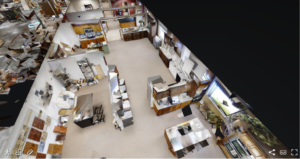By Jamie Novinger-Toigo
No surprise to anyone in 2021, disasters come in all shapes and sizes when least expected. In a 2018 article, FEMA referenced that “60 percent of Americans are not practicing disaster preparation, and even those that do, often lack the basic supplies required for survival.” The article went on to state that “it can be easy to shrug off the threat of a major disaster and tell yourself, ‘That won’t happen where we live.’” Going forward to 2021, our country and the entire world have experienced firsthand how our lives can change with a disaster.
When you are not exposed to the devastations that result from a disaster, it is easy to dismiss the urgent need to prepare for the “what if.”. Preparation can be as easy as asking questions to encourage proper planning in the event of a disaster. What is done in advance of an emergency may be more important than what is done after. Why? It is hard to establish priorities when your business experiences a disaster. The pressure and multitude of items that may be insurmountable at that very moment make it extremely challenging to pause, get organized, and enforce a plan that will be critical to your operation’s recovery.
In its natural disaster recovery guide, the U.S. Chamber of Commerce advises businesses to implement their recovery plan as soon as a disaster strikes. “Implementing the plan will ensure the correct policies and procedures are carried out. …” The U.S. Chamber of Commerce has recommended a few great tips to make the planning process more manageable, including cultivating partnerships with the local community. “The U.S. Chamber of Commerce also recommends that small businesses cultivate partnerships and relations with the local community, including other businesses, local government agencies, and non-profits, which may be able to collectively advise, support, and help one another.” Through a multitude of associations and publications, it is easy to cultivate these local relationships.
Often there are companies that a business may not typically work with until a disaster strikes. Now is the time to identify which companies you want to initiate a relationship with so you have a comfort level with them and confidence in their capabilities. After an incident disrupts business operations, these resources will be needed to carry out recovery strategies and to restore normal business operations.
The most important step is to develop a Resource List. Business continuity planners often recommend developing a relationship with a commercial real estate agent and a restoration company as priority resources in your recovery plan. The impact these predetermined relationships can make will be imperative for emergency restoration services and emergency relocation with designated contingency sites.
Recovery strategies require resources including people, facilities, equipment, materials, and information technology. An analysis of the resources required to execute recovery strategies should be conducted to identify any gaps. Staff with in-depth knowledge of business functions and processes are in the best position to determine what will work. Recovery strategies are alternate means to restore business operations to a minimum acceptable level following a business disruption and are prioritized by the recovery time objectives (RTO) developed during a business impact analysis.
During your pre-planning, some items that should be considered a priority including documenting the current condition of your property, floorplans, condition of the structure, and contents. This does not need to be a daunting task. It could be as simple as making a video while you tour the property. For advanced planning, outsourcing this service to invest in 3D virtual documentation will enable you to utilize various tools for a multitude of options including taking potential clients for a tour of the location, having a walk-through which can be utilized for disaster planning purposes, or having your entire facility and contents documented to a level that leaves no question of the current conditions. Another feature is a floorplan generated for the structure and the ability to obtain measurements from the 3D rendering.
Recently, a business looking to relocate asked us to conduct a 3D scan of a potential facility. The scan captured the exact dimensions and layout of the current structure. The accuracy of the documentation allowed the business to better see the space and strategize how to modify the existing layout in order economically fit out the space with the best workflow. The business met with their team multiple times to revisit their conceptual plan and was able to get their staff’s collective agreement on how the new facility design would enable streamlined operations. After the process was completed, the client noted how much time and money the business saved by reviewing the scans with their staff. They noted the virtual walkthrough made it feel like the staff was in the facility doing the walk-through. The 3D imaging of the space helped initiate great thoughts from staff beyond just a relocation perspective.”




Properly documenting your business’s current condition is extremely important in protecting the investment you have made in your assets. After a property disaster, the damage will need to be clearly documented and recorded in a comprehensible program that can be utilized to assist with processing your insurance claim. To have pre-planned and previously documented the structure and the make-up of the interior would eliminate any question about how the property should be returned to a pre-loss condition. The visual evidence would enable the insurance company to handle the claims process more efficiently, enabling your business to proceed with an agreed plan. Part of a comprehensive disaster plan should include who is going to identify and record the damage, so this vital task can be carried out without hesitation or delay.
From power outages and cyber-attacks to Mother Nature wreaking havoc, preparation is the key to recovery from an unexpected situation. Your business is like a chain – every link represents an important part of your operation and needs your attention in your continuity planning.
There are great resources available to help businesses successfully plan and recover from a disaster, such as:
- Business continuity plan examples and steps to consider for success
- Insight on how to conduct a business impact analysis to identify time-sensitive or critical business functions and processes
- Tools on how to identify, document, and implement critical business functions and processes for recovery
Many tools are available at FEMA / Ready.gov
- Standard on Disaster/Emergency Management and Business Continuity Programs – National Fire Protection Association (NFPA) 1600
- Professional Practices for Business Continuity Professionals – DRI International (non-profit business continuity education and certification body)
- Open for Business® Toolkit – Institute for Business & Home Safety
Through strategic collaborations now, your focus will shift from planning to building your business and thriving through any situation. If your business was able to adapt and get through the challenges of the 2020 pandemic, you have overcome a major disaster. With careful planning, you can ensure a quick and smooth recovery in the event of a property disaster or emergency.

Jamie Novinger-Toigo
Jaime Novinger-Toigo is President & Owner of Service1st Restoration, a Property Disaster Restoration Company serving Pennsylvania. Service1st offers an Emergency Preparedness Partnership to help businesses take a proactive approach to disaster recovery. Service1st Restoration is a qualified women business enterprise through WBENC, as well as an industry certified firm through IICRC and a certified member of COSTARS, the Commonwealth of Pennsylvania’s cooperative purchasing program. Jaime is also the creator of Coworking at The Park, an office space designed to build community engagement with entrepreneurs and like-minded individuals. Jaime is also a co-owner of Organic Remedies, a Medical Marijuana Company, focused on patient care and unlocking the therapeutic benefits of marijuana through research.
Featured in Harrisburg Commercial Real Estate Review – Quarter 2, 2021

